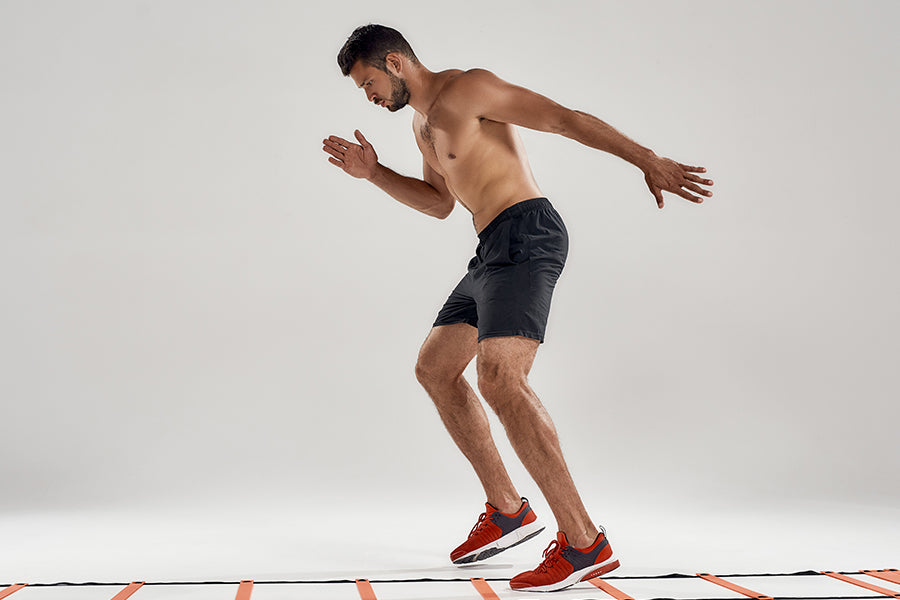Lacrosse has taken its game to the next level, requiring exceptional physical prowess from all players. Speed, agility, strength, and power are now fundamental for success on the field - minus any reliance on positional smarts or brute force alone.
For elite lacrosse players, training isn't just about strength and power - it's also about translating that to the field. So, let us look at workouts that make these pros unique when they step back onto their home turf.
What Muscles Should You Train for Lacrosse?
Glutes, the hamstrings and calves of the posterior chain, the rotating core muscles, and both push and pull muscles of the upper body, including the lats (such as the deltoids and pecs).
If we had to rank them, they would be in that order, but in reality, lacrosse players should concentrate on training kinetic chains rather than specific muscle groups. For speed, agility, and athleticism, lacrosse players need to strengthen their posterior chain (hamstrings, calves, etc.), which is the powerhouse of the lower body.
To improve their capacity to withstand contact, rotate, and shoot harder, they must strengthen their core (which includes the rectus abdominis and the obliques, erectors, and muscles of the low back).
They must build up their upper body (both pull and push muscles) to play more forcefully and shoot more. They require full-body strength, which is why it's crucial to establish complementary integrative kinetic chains.
Best Exercises for Lacrosse
Lacrosse is a competitive and energetic sport requiring players to be physically and mentally strong. To stay on top of their game, lacrosse players must include practical exercises in their training regime. Following are the five best exercises for lacrosse that every player should be familiar with:
1. Box Jumps

Box jumps are an excellent alternative to lifting free weights that can help you build power and explosiveness. They are also excellent plyometric exercises that can adjust their difficulty to accommodate beginners.
- To perform a box jump, you must first position yourself to stand in front of a box or another high surface.
- Get into a quarter squat position, then explode onto the box with both feet.
- When you land, ensure your feet are on the box and bend your knees to absorb the shock.
- Afterward, get yourself up to your full height and leap from the box.
- Perform multiple repetitions of this.
This exercise encourages athletes to perform multiple defensive actions with greater speed and accuracy. By teaching them how to gain power during their jump and land with greater control, box jumps can add the confidence needed in taking on opponents while playing lacrosse.
While learning this drill, lacrosse players build strength in their legs, core, and glutes while improving balance, helping them become stronger and more well-rounded athletes. So next time you're gearing up for a lacrosse practice session or tournament, incorporate some box jumps into your warmup routine!
Related Article: How to Do Box Jumps: The Right Way to Build Explosive Strength
2. Agility Ladder

Anyone who has ever witnessed a game of lacrosse at the professional level knows that the players are exceptionally nimble. To tell you the truth, having a fantastic time for the 40-yard dash is not nearly as crucial as having the capacity to alter course in the blink of an eye. Players in the sport of lacrosse should place a greater emphasis on agility than straight-line speed.
- Start at the bottom of the apparatus with the agility ladder set out in front of you while you get ready for the exercise.
- Before stepping up the speed and intensity, practice the movement gently and carefully. Start with relaxed shoulders and proper posture, with your knees slightly bent. Throughout the practice, move normally while allowing your arms to hang at your sides.
- Your right foot should enter the first square first, and you should immediately plant it and shift your weight to it.
- Put your left foot into the second square. Put the foot down quickly, then shift your weight to that foot.
- Step into the third square of the agility ladder and repeat movement #1.
- Step into the fourth square of the agility ladder and repeat movement #2.
- until the finish of the sequence, keep moving up the agility ladder.
Players put a lot of effort into their agility by performing drills using ladders and step hurdles from behind the net. This helps them become more nimble.
Running in and out of the gaps between the rungs of a ladder and making sudden direction changes are required of participants in ladder drills. Regardless of your fitness level, the countless ladder variations make it a very effective tool for improving your feet and coordination.
3. Bulgarian Split Squat

The lower body will benefit from this workout by developing a solid foundation of strength. Lacrosse players need to be strong in order to apply the necessary braking forces when evading and the necessary propelling forces while accelerating. To perform this exercise following is the breakdown of the movement:
- Put a box or a step behind you, and then stand as tall as possible.
- Place your right foot on the top of the step, and then bend your knees and drop your hips until your left thigh is parallel to the floor.
- Repeat the process when you have returned to the starting location.
- Swap out the legs.
The variation of this workout that uses a kettlebell is an excellent choice for beginners. It helps maintain correct posture while increasing the single-leg strength necessary for lacrosse players.
4. Sled Push

Sled Push is an effective exercise variation that allows you to gain strength and power while adding diversity to your workout routine. Depending on the sled's load and the drill's speed, a Sled Push exercise can provide a great endurance or explosive speed workout.
It helps boost drive and firing mechanics from the hips throughout all muscles involved, which can help improve sports performance. Following are the steps to perform this exercise:
- Put some weights on a prowler sled.
- Put yourself behind the sled.
- One hand should be used for each bar.
- Lean forward from the waist.
- Press your legs firmly into the ground.
- Drive the sled ahead by pushing it.
Achieving the correct alignment of the body to apply forces in a horizontal direction is an essential component of acceleration. Because of the sled's resistance, the competitors must ensure they are in the optimal position to succeed. The mechanics of punching and driving, used to produce force, are transferable to any acceleration that may occur while playing lacrosse.
Unlike running with no resistance, pushing a weighted sled requires increased body control and can help enhance coordination and strength. This makes it ideal for those athletes looking to strengthen their entire body for a more competitive edge.
5. Trap Bar Deadlifts

A modification of the standard deadlift, known as the hex bar deadlift, the hex bar deadlift allows you to lift large weights while putting less strain on your lower back than the regular deadlift.
Because it is done while standing inside a bar shaped like a hexagon, this particular exercise is sometimes referred to as the trap bar deadlift. Here's a step-by-step guide on how to perform this exercise correctly.
- Obtain a trap bar and add the necessary amount of weight to it.
- Step into the trap bar and stand with your feet shoulder-width apart and pointing forward.
- Make sure you are standing in the middle of the trap bar.
- Squeeze your glutes and start bending at the hips and then the knees to lower Yourself from this position.
- Make sure your spine is as neutral/flat as possible when you hold onto the trap bar's handles.
- Look forward, around six feet in front of you, with your arms straight.
- If you are in the right position, your hamstrings should feel slightly stretched.
- Inhale deeply and hold it in. Drive your feet into the ground to completely extend Your hips and knees before starting the pull.
- Stretch your glutes to stand up straight.
- Maintain the same back angle throughout the exercise.
- Break at the hips first, then at the knees, and perform the movement in reverse precisely as you did when you started.
The hex bar deadlift is a great workout that may be used to develop strength, power, and explosiveness in the lower body.
Lacrosse players should aim to get in the gym between three and five times each week. With a total of three strength sessions, two-speed workouts, and one to two conditioning or mobility workouts included. This will be determined by the time of year and the specific requirements of the player's growth.
Related Article: 10 Highly Effective Deadlift Alternatives for Beginners, At-Home Workouts, and More
Take Away
All these drills will help you develop your agility, coordination, and strength, the three most essential components for achieving athletic success on the lacrosse field. Lower body strength and speed become more of a factor as the game progresses than they ever have been before. This is something that you will notice as the game progresses over time. In addition to putting in hard work in the gym, make sure you give yourself enough time to recover properly so that you can see the benefits of your efforts on the field.











